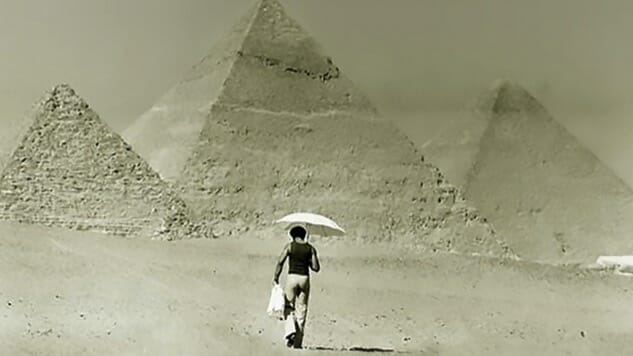
If George Clinton’s Parliament-Funkadelic suggested what the Sun Ra Arkestra might have sounded like if fronted by Sly & the Family Stone, Maurice White’s Earth, Wind & Fire hinted at what the Count Basie Band might have sounded like if fronted by the Temptations. The two organizations dominated funk music during the 1970s, and with their propulsive rhythms, extended solos and contrapuntal horn charts, they were big bands for a new era.
White’s death last Wednesday at age 74 after a long bout with Parkinson’s disease was a belated reminder that his troupe was once running neck and neck with Clinton’s. If P-Funk found more favor with the critics, EW&F found more with record buyers. In this century, however, both personal memories and written histories have magnified Clinton’s legacy while allowing White’s to shrink. It’s impossible to deny P-Funk its due, but EW&F deserves some love too.
White, a session drummer for Chess Records and a member of the Ramsey Lewis Trio, headed west to L.A. in 1970 with a concept for a self-contained rock band that would incorporate his jazz and soul experience. You can hear him closing in on that concept with his two modestly selling albums for Warner Bros. before revamping his line-up to include falsetto specialist Philip Bailey, jazz keyboardist Larry Dunn and ex-Chess arranger Charles Stepney. Their first album for Columbia, 1972’s Last Days and Time, included the strangest Pete Seeger cover of all time and an eight-minute, free-form jazz-funk instrumental jam.
It all clicked into focus on the sixth EW&F album, The Way of the World, the soundtrack for a flop movie and the source of the all-conquering single, “Shining Star.” That song opened with a clipped funk guitar riff and a blast of horns, gave way to a chant traded back and forth by White’s gruff low tenor and Bailey’s stratospheric tenor and shifted to swing time for a deftly harmonized chorus hook. On the second verse, Dunn and guitarists Al McKay and Johnny Graham started tossing fusion licks into every possible space; pretty soon so much was happening at once that your head spun to listen. But the song never lost its groove.
This set the standard for a run of five triumphant albums that also included Gratitude, Spirit, All ‘N All and I Am. Bailey’s high tenor and White’s low tenor sounded like the second coming of the Temptations’ Eddie Kendricks and David Ruffin. White’s younger brothers, bassist Verdine and drummer Fred, nailed down a non-negotiable funk beat. That groove served as the star that many planets of sound could orbit around: rock guitar, jazz horns, Latin percussion and R&B vocal harmonies.
White deserves credit for introducing third-world elements into American pop long before it was fashionable. Not only did he feature the kalimba, an African thumb piano, in the studio and on the stage, but he encouraged the band to play rhythms against rhythms to create a groundbreaking worldbeat crossfire. He also rethought the role of horns in rock bands, expanding it from percussive punctuation to harmonies that blended like Motown back-up singers.
On the other hand, White deserves the blame for some of the worst pop lyrics this side of Yes. Not only did his songs vainly try to describe some vague cosmological gobbledygook, but they often did so in torturous syntax. As he sings on “Serpentine Fire,” “Influences stray my mind to disagree; I wanna see your face in the morning sun ignite my energy.” And after 1978’s “I Am,” the quality of the EW&F albums dropped precipitously, the vigorous big-band funk giving way to good-vibes chants over programmed synths.
When it was good, though, White’s band was very good indeed. When I saw them at Maryland’s Capital Centre in 1979, the live show was still terrific. The stage was built like a pyramid—Egyptian motifs were a constant in the stage design, album covers and costumes—with flashing lights marking each tier. The 16 performers—including five horns, four percussionists and the female vocal trio known as the Emotions—entered in shimmering costumes that suggested Egyptian royalty kidnapped by intergalactic aliens and returned to earth as disco stars.
The numbers made a difference, for White could assign the central groove to one battalion of his forces and let other detachments make raids on far-flung fronts. On “Star,” for example, when Bailey’s falsetto had pushed the melody to a seeming peak, trumpeter Michael Davis climbed to the top of the pyramid for an improvisation that took the tune even higher. On “Be Ever Wonderful,” White’s preacher-like vocal was backed by the Emotions’ wailing church harmonies and Lew Satterfield’s saxophone commentary.
White introduced “Shining Star” with a thumb-piano solo, and when his brother Verdine stepped from a puff of smoke with the bass figure that anchored the song, you could hear the connection between Nigeria and Chicago. And when McKay added a long Santana-esque guitar solo, you could hear the link between mainstream R&B and post-Zeppelin rock. And in the solos of trumpeter Don Myrick and keyboardist Dunn, you could hear the thread from Basie at the Roseland Ballroom and Earth, Wind & Fire at a basketball arena.
When people remember the jazz-rock fusion era of the ‘70s, they usually talk of jazz musicians like Miles Davis, John McLaughlin, Chick Corea and Herbie Hancock who plugged in and rocked out. Seldom mentioned are the acts who jumped in from the rock side of the boundary, but it was bands like Steely Dan, Santana, Parliament-Funkadelic and Earth, Wind & Fire who added sophisticated horn charts, quirky chord changes, improvised guitar and third-world percussion to their pop songcraft and came away with some of the best albums of the decade. Let us not forget them.